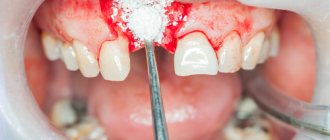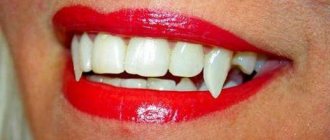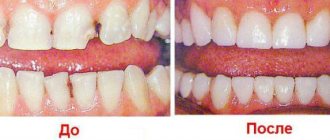The tasks of modern dentistry include not only the treatment of teeth, but also the elimination of their aesthetic defects: chips, cracks, darkening of the enamel, anomalies in shape and size. Sometimes dentists encounter unusual requests from patients. For example, the service of canine extensions is becoming increasingly popular. We are not talking about the standard restoration of a damaged tooth, but about changing its shape. It becomes more pointed and elongated. Visually, such fangs resemble “vampire” ones.
Vampire smile: how and why they grow fangs today, what risks are associated with the procedure
Modern dentistry has a whole arsenal of techniques and technologies that make it possible to restore the integrity of damaged teeth and the appearance of a smile in a wide variety of clinical cases. But there are other situations when modeling the shape of individual teeth has nothing to do with violations of their integrity. Today we will talk about canine extensions, which are most often carried out with the goal of adding a “zest” to your smile and your image as a whole. Why do people do this, what methods are used to make vampire fangs today, and whether they are so harmless - read further in our article.
What could be the motivation?
Fangs can be extended or restored for dental reasons or for beauty.
For medical purposes, canine extensions are necessary for the following purposes:
- the enamel is damaged or has microcracks;
- the tooth has damage from deep caries or the hard tissue has suffered mechanical damage;
- the tooth wears out with age;
- for defects that cannot be corrected aesthetically;
- There is pronounced pigmentation on the enamel.
In order to improve (change) their appearance, each person makes an independent decision about the advisability of growing fangs.
Over the past few years, this procedure has only gained popularity. Patients are confident that restoration of certain teeth can correct their facial expression and make their smile more mysterious and unusual. They are confident that they will acquire a certain charm and novelty.
In most cases, manipulations on the fangs are performed only for decorative aesthetics.
Why do they grow fangs?
An adult has 4 fangs in his mouth - 2 on the upper jaw and 2 more on the lower jaw. These are the third elements from the central line that close the group of frontal teeth. Usually they do not differ much in length from their “neighbors”. However, recently, more and more often, teenagers and young people, passionate about mysticism and the theme of vampirism, want to lengthen their fangs in order to make their image original and their smile unusual or even frightening. Today this desire can be fulfilled by a dentist.
Most often, this is done using the direct method, but there are other methods. The maximum permissible length of the modified canine should be no more than 4 mm1. If the tooth is longer than this norm, it can create some discomfort and increase the risk of injury to the mucous membrane.
The vampire smile is increasingly in demand among teenagers
Causes of impacted teeth
- Due to injury or damage to the jaw;
- If the child’s primary fangs were pulled out prematurely;
- Incorrect location of the tooth germ;
- Dental crowding, which means teeth are too close together;
- Inflammatory diseases of baby teeth and gums;
- The presence of “extra” teeth (supercomplete);
- Poor nutrition;
- Rickets;
- Exhaustion or weakness of the body.
The main prerequisite for the appearance of retention is the peculiarities of the child’s development in the embryonic period (lack of minerals in the body, thickening of the mucous membranes, low fetal growth rate).
Are there any reasonable indications for the procedure?
This procedure is most often performed for aesthetic purposes, but dental experts also identify several compelling indications for its implementation. Thus, such a modification may be useful if there are problems with the appearance of the enamel, pigment spots, damage to the teeth, if most of the tissues have been damaged by caries or have chipped off as a result of injury.
“Six months ago I grew my fangs. I’ve been dreaming about it for a long time, back when vampire sagas were just gaining popularity. And not so long ago I learned that this can be done in dentistry. I paid only 10 thousand for this beauty. I just had my teeth grown; I didn’t get any veneers, much less crowns. I'm still very happy with the result! The main thing is not to overdo it with the length.”
Olchik92, Moscow
However, such restoration has more limitations than indications. Therefore, before you decide to get vampire fangs, you need to consult a dentist and undergo an appropriate examination.
Before the procedure, you should definitely consult a specialist.
Symptoms of tooth impaction
In most cases, an impacted tooth is detected on an x-ray at the dentist or at an appointment with an ENT doctor. Retention in a child can be determined if one of the elements of the jaw row is absent for a long time or if a baby tooth is not replaced by a permanent “brother” for too long. The eruption of an impacted tooth is usually accompanied by inflammatory processes. The child may be bothered by swelling of the gum tissue and jaw, pain and aches, numbness and tingling in the retention zone.
On palpation of the gums, thickening and hardening are noted, reminiscent in shape and outline of an unerupted tooth.
When is it contraindicated to grow fangs?
The procedure under consideration has a whole list of strict restrictions. The main contraindications are listed below:
- presence of signs of periodontitis - inflammation in periodontal tissues,
- problems in the root area,
- malocclusion – possible displacement of the chewing load and excessive pressure on individual elements of the row,
- low level of oral hygiene,
- allergy to the material used for extensions,
- pathological abrasion of enamel, etc.
If you ignore the above phenomena, you can cause serious damage to the condition of your living teeth. If they require restoration, but the patient also wants to slightly change their shape, you can try to eliminate the defects and then install veneers or crowns.
A tooth started to loosen: how to save it at home
If a tooth is loose, you can save it at home (as part of complex therapy). In the initial stages, massage of the gums and the area around the loose tooth helps. It is important to perform it systematically (twice a day for 3–4 minutes). Problem areas are massaged in a circular motion without causing excessive stress. After each massage session, it is necessary to rinse your mouth with a decoction of medicinal herbs (for example, chamomile or sea buckthorn).
Also, at home you need to use gels that relieve inflammation and improve blood circulation in tissues (as prescribed by a doctor) and adjust your usual diet (add foods rich in vitamins and minerals).
How is extension carried out - methods
Today, dental clinics use various methods of canine restoration for this purpose. The choice of method will depend on the initial condition of the teeth, the wishes of the patient and the individual recommendations of the doctor.
Extension using the direct method
This is the most gentle method, which involves modifying the shape of the tooth directly in the patient’s mouth. It is carried out by layer-by-layer application of composite material. When the mold is ready, the tooth is ground and polished. In this case, the parameters are selected taking into account the individual characteristics of the dentofacial apparatus, and the entire procedure takes about 1.5 hours.
The photo shows direct canine extensions
Installation of veneers or lumineers
Veneers are the thinnest overlays on teeth that are fixed on their front side, allowing you to hide defects, yellowness, small chips and cracks and at the same time give the element the desired shape. But before installing such overlays, it is necessary to grind off the enamel somewhat to improve adhesion. Next, the doctor applies an adhesive composition to the prepared surface and fixes the veneer. A more advanced and expensive option is lumineers - these are ultra-thin plates, the fixation of which usually does not require preliminary preparation.
You can grow your teeth with veneers
Installation of artificial crowns
The most radical method is crown prosthetics. The procedure is quite labor-intensive and usually requires extensive preparation of living hard tissue. In this case, artificial crowns are created taking into account the anatomical features of the patient’s jaw system and can be installed on ground teeth, stump inlays or pins.
First, the specialist makes an impression, which is then sent to a dental laboratory, where an artificial fang is created based on it. It can be made of metal ceramics or zirconium dioxide. The latter option is considered more preferable today, since, along with high aesthetics, it is characterized by increased wear resistance and strength.
The issue can also be resolved using crowns
Contraindications
The extension procedure has a number of contraindications. They may vary depending on the restoration methods used .
For the main method - therapeutic - there are not too many contraindications:
- Diagnosing a patient with certain forms of periodontitis .
- Bite pathologies , in which, due to an extended tooth, the load on the jaw will be incorrectly distributed.
- Complete destruction of the fang , when the only way to change its shape and size is to install an artificially created crown.
- Lack of hygienic procedures for caring for the oral cavity and teeth.
- If patients are people with special needs who cannot provide full care for an artificial structure .
- Allergic reactions to composite materials are quite rare, but are also a contraindication. In this case, other methods of extension can be used, without taking into account the therapeutic direct one.
Caries can also be considered a contraindication for canine extensions, however, conditionally. The fact is that eliminating the carious cavity and the consequences of the disease is necessary not only on the canine being restored, but also on the remaining teeth, since this can bring negative consequences in the future.
However, caries can be treated quite simply and very quickly with modern methods, so it only serves as a short delay before building up.
If the patient has too much abrasion of the enamel, then the extension will have minimal effect . It is not recommended until the existing problem is solved in a more radical way - complete orthopedic correction.
Also among the contraindications we can mention the length of the extended fangs more than 4 mm . As already mentioned, this is a traumatic factor.
However, the length of 4 mm is approximate. Depending on the individual characteristics of the jaw, bite and teeth themselves, it can fluctuate by 0.5 mm up or down.
How to properly care for your mouth after extensions
Extended fangs require increased attention and special care. It is extremely important to strictly follow all hygiene rules to prevent the development of caries and other dental problems. In this regard, experts make the following recommendations:
- Daily brushing of teeth should be carried out at least twice a day,
- It is better to give preference to non-abrasive toothpaste and a brush with medium or soft bristles,
- give up coffee and strong tea, quit smoking if possible,
- Regularly visit the dentist’s office for preventive examinations and respond in a timely manner to any emerging signs of pathological processes.
Proper dental hygiene is important to maintain a smile.
To ensure that vampire teeth last as long as possible, after extensions the dentist will cover them with a special varnish. It will provide protection that will prevent damage to the material due to the aggressive effects of acids and coloring pigments. As for the age at which the procedure can be carried out, experts agree in one opinion - it is better to resort to such modifications from the age of 16-18, but not earlier.
Stages
The manipulation of obtaining extended fangs for girls and boys is carried out in several stages:
- grinding of hard tissue, which is necessary to create the correct shape of an artificial fang (even when constructing fangs of the “vampire” type);
- insulating the treated dental surface from moisture using latex material with a special hole for the tooth;
- enamel conditioning, which ensures its reliable adhesion to composite materials;
- the use of adhesive systems – for a more durable connection of the composite with dentin.
What are the pros and cons?
Most often, fangs are extended at will, to create an unusual image. This modification has both certain advantages and significant disadvantages.
| Advantages | Flaws |
|
|
Installation of “vampire” shaped crowns
There are quite exotic extended fangs.
Vampire crowns are made and installed in the same way as regular crowns. The only distinctive feature of such products is their shape. The procedure technology is as follows:
- a cast is made;
- a dental technician makes a “vampire” crown - initially a test model is made from plaster, on the basis of which a permanent crown will be produced;
- the finished model is tried on by the patient and, if necessary, it can be sent for revision;
- temporary structures are installed that the patient must wear for two weeks;
- Using special cement, a permanent metal-ceramic or ceramic “vampire” crown is fixed, which is installed on a previously ground tooth.
As a result of grinding the tooth, the enamel is severely damaged, but it is thanks to this procedure that the artificial structure is fixed most reliably and firmly.
When choosing this method of growing fangs, you need to know that it will be impossible to return the previous shape of the tooth.
Photos of girls' extended fangs are also presented.
How much does the procedure cost?
It is quite difficult to give an unambiguous answer to the question of how much it costs to grow fangs, since much will depend on the chosen technique. Also, other factors will influence the final price, including the quality, quantity and cost of the material used, the pricing policy of the dental center and the professional status of the specialist.
It can be immediately noted that a vampire smile can cost the patient from 3-4 to 30-40 thousand rubles. With additional decor such as skyes and stones, the cost of the procedure can reach 200 thousand rubles. The price range is significant, so it is better to consult a specialist about choosing a specific technique.
A standard cosmetic restoration will cost on average 3-5 thousand rubles. But it must be taken into account that for such a procedure it is important that there are no pathological processes in the oral cavity, especially in the acute stage. Treatment of foci of caries and inflammation, enamel hyperesthesia if present - all this will entail additional expenses and increase the total cost.
Installation of one ceramic composite veneer, the most affordable, will cost from 20 thousand rubles. More expensive solutions made of ceramics and on a zirconium dioxide frame will cost from 25 to 30 thousand rubles. for 1 veneer. If we talk about lumineers, their cost ranges from 45 to 65 thousand rubles. for one overlay. As for installing an artificial crown, its cost will also directly depend on the material. Thus, a metal-ceramic structure can cost from 15 to 20 thousand rubles. A zirconium product will cost 20-25 thousand rubles.
If you decide to grow fangs, carefully consider all the pros and cons in advance, and be sure to consider the possible risks. This is one of the original options to dramatically change your image, but you need to understand that we are talking about the health of your teeth and oral cavity in general. Sometimes such transformations cause serious damage to the enamel, which most often happens due to a violation of the technique of the procedure or the presence of contraindications in the patient that were not identified in advance. Therefore, if you decide to take such a step, carefully and responsibly approach the choice of a clinic and a good doctor.
- Bulycheva T.E. Aesthetics of a smile, 2007.
Restoration using veneers
This extension method uses porcelain or ceramic plates that have identical properties to enamel. They are glued using special solutions to the prepared surface of the fang. As an alternative to veneers, lumineers are often used, which are distinguished by a special manufacturing technique that allows the production of extremely thin plates (no more than 0.3 mm). With the help of such overlays it is possible to simultaneously get rid of various defects - darkening, chips and stains on the enamel.









